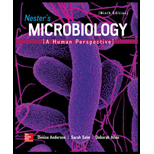
Nester's Microbiology: A Human Perspective
9th Edition
ISBN: 9781259709999
Author: Denise G. Anderson Lecturer, Sarah Salm, Deborah Allen
Publisher: McGraw-Hill Education
expand_more
expand_more
format_list_bulleted
Concept explainers
Question
Chapter 4, Problem 3SA
Summary Introduction
To explain:
The events that occur during the five phases of growth.
Introduction:
The microorganisms in the laboratory are grown on agar plates or in the tubes and are considered as closed systems or batch culture because nutrients and wastes are not removed. When the cells grow in this type of system, their population increases in a definite pattern of stages and then declines. This characteristic pattern is known as a growth curve.
Expert Solution & Answer
Want to see the full answer?
Check out a sample textbook solution
Students have asked these similar questions
glg 112 mid unit assignment Identifying melting processes
Give only the mode of inheritance consistent with all three pedigrees and only two reasons that support this, nothing more, (it shouldn't take too long)
O
Chapter 4 Solutions
Nester's Microbiology: A Human Perspective
Ch. 4 - Describe a detrimental and a beneficial effect of...Ch. 4 - Define a pure culture.Ch. 4 - Prob. 3SACh. 4 - Explain how the environment of a colony differs...Ch. 4 - Prob. 5SACh. 4 - Why would botulism be a concern with canned foods?Ch. 4 - Explain why O2-containing atmospheres kill some...Ch. 4 - Explain why photoautotrophs are primary producers.Ch. 4 - Distinguish between a selective medium and a...Ch. 4 - Prob. 10SA
Ch. 4 - Prob. 1MCCh. 4 - Compared with their growth in the laboratory,...Ch. 4 -
3. Cells are most sensitive to penicillin during...Ch. 4 - Which best describes the intestinal tract? a) An...Ch. 4 - E. coli, a facultative anaerobe, is grown for 24...Ch. 4 - The generation time of a bacterium was measured at...Ch. 4 - Which of the following is false? a)E. coli grows...Ch. 4 -
8. If the pH indicator were left out of MacConkey...Ch. 4 -
9. A soil sample is placed in liquid and the...Ch. 4 -
10. If the concentration of E. coli in a broth is...Ch. 4 -
1. You are a microbiologist working for a...Ch. 4 - High-performance boat manufacturers know that...Ch. 4 - This figure shows a growth curve plotted on a...Ch. 4 - Prob. 2CT
Knowledge Booster
Learn more about
Need a deep-dive on the concept behind this application? Look no further. Learn more about this topic, biology and related others by exploring similar questions and additional content below.Similar questions
- Describe the principle of homeostasis.arrow_forwardExplain how the hormones of the glands listed below travel around the body to target organs and tissues : Pituitary gland Hypothalamus Thyroid Parathyroid Adrenal Pineal Pancreas(islets of langerhans) Gonads (testes and ovaries) Placentaarrow_forwardWhat are the functions of the hormones produced in the glands listed below: Pituitary gland Hypothalamus Thyroid Parathyroid Adrenal Pineal Pancreas(islets of langerhans) Gonads (testes and ovaries) Placentaarrow_forward
- Describe the hormones produced in the glands listed below: Pituitary gland Hypothalamus Thyroid Parathyroid Adrenal Pineal Pancreas(islets of langerhans) Gonads (testes and ovaries) Placentaarrow_forwardPlease help me calculate drug dosage from the following information: Patient weight: 35 pounds, so 15.9 kilograms (got this by dividing 35 pounds by 2.2 kilograms) Drug dose: 0.05mg/kg Drug concentration: 2mg/mLarrow_forwardA 25-year-old woman presents to the emergency department with a 2-day history of fever, chills, severe headache, and confusion. She recently returned from a trip to sub-Saharan Africa, where she did not take malaria prophylaxis. On examination, she is febrile (39.8°C/103.6°F) and hypotensive. Laboratory studies reveal hemoglobin of 8.0 g/dL, platelet count of 50,000/μL, and evidence of hemoglobinuria. A peripheral blood smear shows ring forms and banana-shaped gametocytes. Which of the following Plasmodium species is most likely responsible for her severe symptoms? A. Plasmodium vivax B. Plasmodium ovale C. Plasmodium malariae D. Plasmodium falciparumarrow_forward
- please fill in missing parts , thank youarrow_forwardplease draw in the answers, thank youarrow_forwarda. On this first grid, assume that the DNA and RNA templates are read left to right. DNA DNA mRNA codon tRNA anticodon polypeptide _strand strand C с A T G A U G C A TRP b. Now do this AGAIN assuming that the DNA and RNA templates are read right to left. DNA DNA strand strand C mRNA codon tRNA anticodon polypeptide 0 A T G A U G с A TRParrow_forward
arrow_back_ios
SEE MORE QUESTIONS
arrow_forward_ios
Recommended textbooks for you
 Biology 2eBiologyISBN:9781947172517Author:Matthew Douglas, Jung Choi, Mary Ann ClarkPublisher:OpenStax
Biology 2eBiologyISBN:9781947172517Author:Matthew Douglas, Jung Choi, Mary Ann ClarkPublisher:OpenStax Biology (MindTap Course List)BiologyISBN:9781337392938Author:Eldra Solomon, Charles Martin, Diana W. Martin, Linda R. BergPublisher:Cengage Learning
Biology (MindTap Course List)BiologyISBN:9781337392938Author:Eldra Solomon, Charles Martin, Diana W. Martin, Linda R. BergPublisher:Cengage Learning Biology: The Dynamic Science (MindTap Course List)BiologyISBN:9781305389892Author:Peter J. Russell, Paul E. Hertz, Beverly McMillanPublisher:Cengage Learning
Biology: The Dynamic Science (MindTap Course List)BiologyISBN:9781305389892Author:Peter J. Russell, Paul E. Hertz, Beverly McMillanPublisher:Cengage Learning

Biology 2e
Biology
ISBN:9781947172517
Author:Matthew Douglas, Jung Choi, Mary Ann Clark
Publisher:OpenStax

Biology (MindTap Course List)
Biology
ISBN:9781337392938
Author:Eldra Solomon, Charles Martin, Diana W. Martin, Linda R. Berg
Publisher:Cengage Learning


Biology: The Dynamic Science (MindTap Course List)
Biology
ISBN:9781305389892
Author:Peter J. Russell, Paul E. Hertz, Beverly McMillan
Publisher:Cengage Learning

